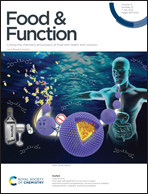Probiotic-fermented black tartary buckwheat alleviates hyperlipidemia and gut microbiota dysbiosis in rats fed with a high-fat diet†
Abstract
Natural plants fermented with probiotics exert beneficial effects on hyperlipidemia and gut microbiota disorders. This study aimed to investigate the hypolipidemic activity of fermented black tartary buckwheat (FBTB) in rats with hyperlipidemia induced by a high-fat diet (HFD) in association with the regulation of gut microbiota. Probiotic fermentation by Bacillus sp. DU-106 obviously increased the contents of tyrosine, lysine, total flavonoids, total polyphenols, quercetin, and kaempferol in black tartary buckwheat (BTB) and significantly decreased the rutin content. FBTB treatment for 8 weeks significantly decreased the levels of serum total cholesterol, triglycerides, and low-density lipoprotein cholesterol in HFD-induced hyperlipidemic rats. Western blot analysis further confirmed that the protein expression levels of FXR, SREBP1, and PPARα were altered after FBTB treatment. Moreover, FBTB intervention altered the gut microbiota of HFD-fed rats by increasing the relative abundances of Lactobacillus, Faecalibaculum, and Allobaculum and decreasing the relative abundance of Romboutsia. The relative abundance of Allobaculum was positively correlated with the levels of tyrosine, total flavonoids, total polyphenols, quercetin and kaempferol and negatively correlated with that of rutin. These results suggested that FBTB could alleviate hyperlipidemia and gut microbiota dysbiosis in HFD-fed rats.



 Please wait while we load your content...
Please wait while we load your content...